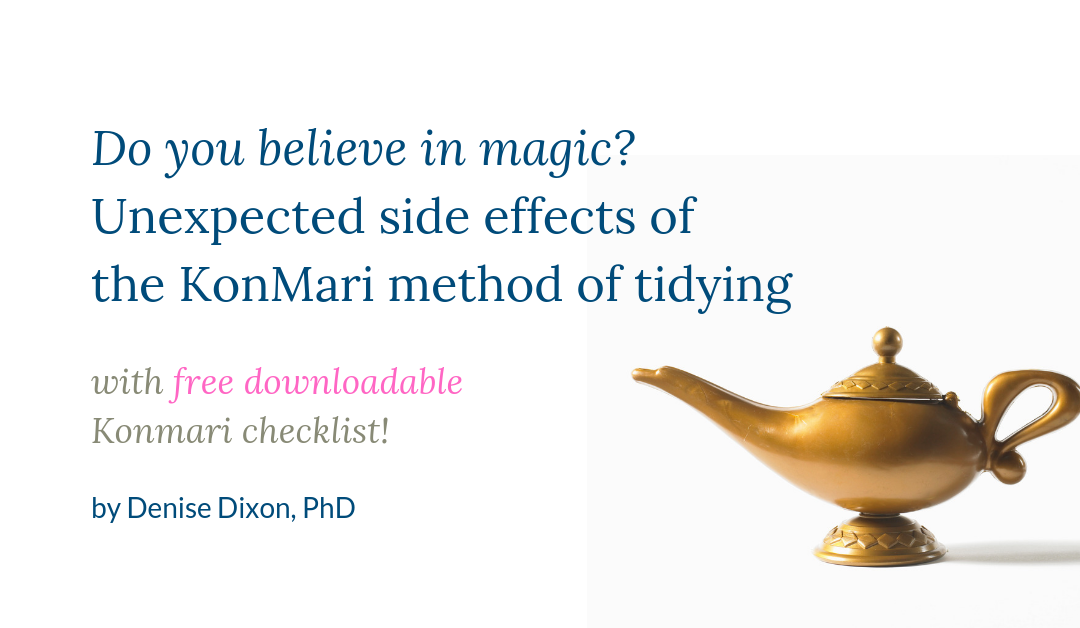In this final blog post (of a 3 part series), we discuss the potential side effects of successfully completing the KonMari method of decluttering.
We answer the following questions:
- What should someone do, when facing some unexpected negative side effects of decluttering with the KonMari method?
- What are some of the surprising positive side effects of the KonMari method?
- Is the KonMari method of tidying really magic?
Let’s continue…
The KonMari method (a review)
Let’s review the basic steps to KonMari method, with the helpful infographic (from a previous post):
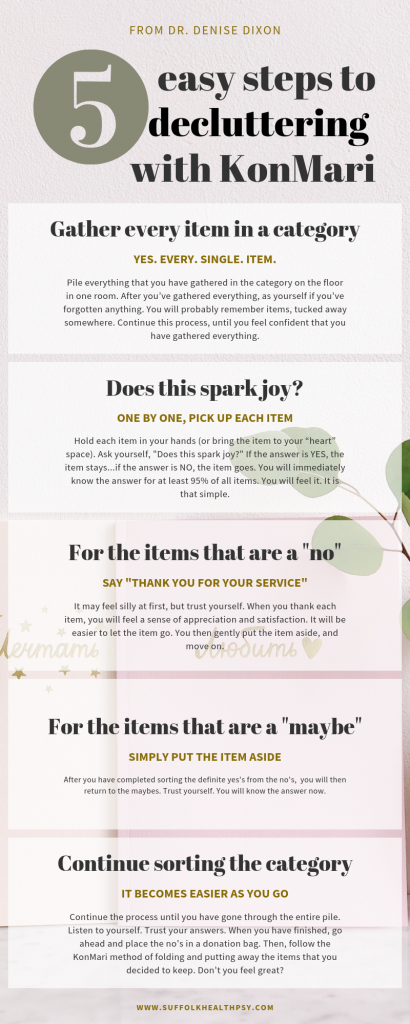
Please feel free to refer to the previous post, where you can read through the basic Konmari steps in more detail (and a larger font).
RELATED: Does Konmari work? A psychologist shares her own journey towards sparking joy (part 1)
Now that we have reviewed the KonMari method, we will turn our attention to some unexpected (and yet fairly common) negative side effects of the KonMari method.
Three potential negative side effects of the KonMari method… and how to cope
First potential negative KonMari side effect:
1
Overwhelm
Feeling overwhelmed seems to be a very common negative side effect of decluttering with the KonMari method.
And — no wonder!
After all, this process forces us to confront piles, mountains, and stacks — of clothing, miscellany, books and paper.
We definitely need a gigantic leap of faith. KonMari is much different from decluttering by location, such as traditional “10 items to throw away today” approaches to decluttering.
While it may seem that only the most courageous and persistent few actually succeed — don’t despair!
So, what is an effective way of dealing with feeling overwhelmed, when attempting the KonMari method of decluttering?
ANSWER: Overwhelm? Break it down!
Specifically, we can use checklists to break down the categories into much more manageable subcategories.
Breaking down the general categories into sub-categories can help tremendously. First, by creating a bit of relief. Secondly, by providing a tangible sense of accomplishment, as each sub-category is completed.
Creating a master checklist can help even more. I’ve created one example:
Free KonMari Checklist
I created this FREE (2-page), highly detailed & comprehensive KonMari Checklist, to help me break down the… ahem… massive KonMari categories, into (much more) manageable sub-categories.
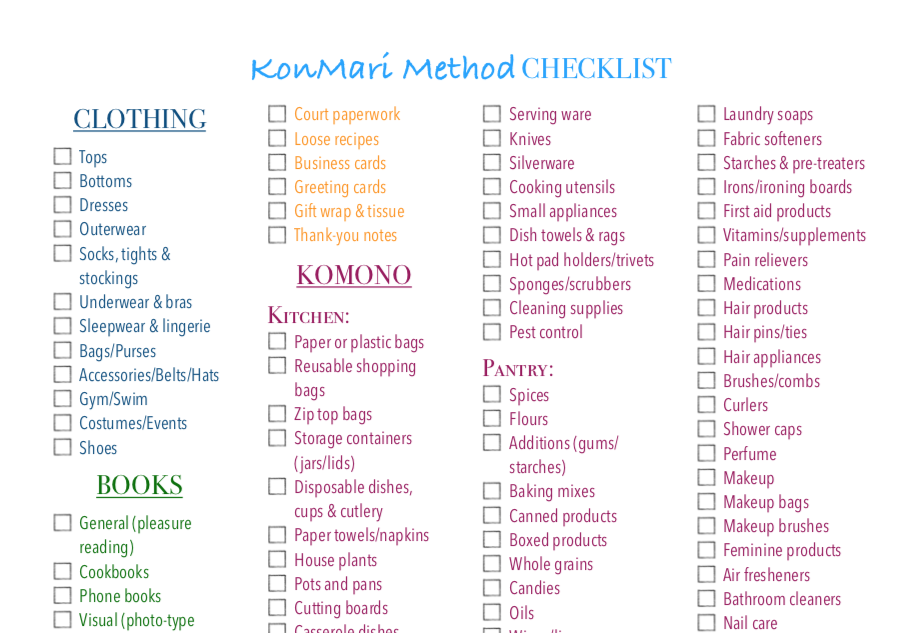
One more suggestion, to deal with overwhelm: It is very, very helpful, to make every effort to dispose of all discarded items AS SOON AS FINISHING EACH SUB-CATEGORY. (Don’t let things pile up in your basement or garage — that will create more clutter, and more overwhelm!) That’s right — bring items directly to the donation or recycling center; or deposit directly to the trash. Whew! Now, doesn’t that feel great?
Second potential negative KonMari side effect:
2
Anxiety
Second to overwhelm, going through the KonMari method of decluttering can lead to increased feelings of anxiety.
This is not surprising. If we follow the KonMari method properly — that is, by sorting in silence, and alone — we can be faced with waves of unpleasant feelings, including anxiety.
It can be very intense.
Also, facing those piles, mountains and stacks — of clothing, miscellany, books and paper — can have us feeling insecure about our ability to succeed.
Facing the (rather daunting) task of decluttering by category (instead of location), can result in catastrophe-type of thoughts, such as, “This is too much! I’ll never get this done! It will take way too long!“
Anxiety
Second to overwhelm, many people have stated that going through the KonMari method of decluttering increased feelings of anxiety.
Sadness
Thirdly, there are quite a few accounts of people have describing that they were unable to find “spark” any joy — stating that attempting to declutter with the KonMari method resulted in feeling even more sad or depressed.
What is an effective way of dealing with (waves of) anxiety, when decluttering with the KonMari method?
ANSWER: First, prepare! And then, return to the “now.”
In general, anxiety is mainly about feeling unprepared, and getting ahead of ourselves.
Therefore, preparation is one of most important first steps, when dealing with anxiety.
Yes – thorough preparation is essential!
Therefore, the strong recommendation, is to read (at minimum) Ms. Kondo’s first book, The Life-Changing Magic of Tidying Up, from cover to cover. Her second book, Spark Joy: An Illustrated Master Class on the Art of Organizing and Tidying Up, offers even more instructions about folding and organizing.
As a bonus, it can be very helpful, to read as many blogs (that focus on success!)
Now — what about this idea of returning to the “now?”
A second way that anxiety grabs us, is by getting ahead of ourselves. So we pull ourselves back to “right now,” breathe, and really focus on each item in our hands, or in front of us, one at a time.
Yes, it’s an intense process, and leads us to our third possible side effect…
Third potential negative KonMari side effect:
3
Sadness
There are quite a few accounts of people that said that they were unable to find (or “spark”) any joy, while going through the KonMari method.
In fact, a some people have reported, that when they tried to declutter with the KonMari method, they ended up feeling worse — even more sad or depressed.
What’s that, all about?
Anxiety
Second to overwhelm, many people have stated that going through the KonMari method of decluttering increased feelings of anxiety.
Sadness
Thirdly, there are quite a few accounts of people have describing that they were unable to find “spark” any joy — stating that attempting to declutter with the KonMari method resulted in feeling even more sad or depressed.
Of course, without knowing the specific details, we cannot be certain.
However, speaking in general terms, sadness (or even depression) can often signal a reluctance (or inability?) to let go of attachments that no longer serve us.
What is an effective way of dealing with sadness, when decluttering with the KonMari method?
ANSWER: “Thank you for your service.”
This is where the KonMari method can be such a profoundly helpful process. When we releasing belongings that have served their purpose, we can release attachments to the past, and move on.
To be successful, it is important to set aside logic, and really lean into our feelings, as we sort through our items.
Next, as mentioned in the previous post, we can forgive ourselves, in advance, for taking a bit longer than expected. After all, life happens, right?
RELATED: A psychologist shares her success (and failure) with the KonMari method (part 2)
Finally, make sure that you did not skip the critical step of asking yourself why you want to embark upon this journey of keeping only those items that speak to your heart, while letting go of the rest! The “why” will help you to keep moving forward, whenever you feel overwhelmed, and want to quit. Also, knowing your “why” will provide you with direction and focus.
Now, for the fun part: three positive side effects of the KonMari method
First positive side effect of the KonMari method:
1
Appreciation
The process of holding each item to our heart — to “feel into determining if each item “sparks joy” — can increase feelings of appreciation for — and satisfaction with — our belongings.
I’ll admit that I found this idea rather… odd… when I first read the book.
“Huh? Feel for joy… from things that I own?“
Despite my doubts (and because I tend to enjoy new experiences), I decided to give it a try.
Initially, I didn’t notice much.
But then, the strangest thing happened.
As I sorted through the first subcategory (“tops”), I noticed that my focus and concentration started to sharpen. As a result, it became easier to feel into differentiating a “yes” from a “no.”
And, the appreciation for all of my items — both the “yes’s” and the “no’s” — grew. Which then lead to the second positive side effect…
Second positive side effect of the KonMari method:
2
Calm
The KonMari method can create (or increase) calm, in several ways.
Joy
After sorting through categories, Ms. Kondo provides clear and concise directions about how to fold and store items. Here is one example:
Importantly, she reminds us to store items so that they are easy to put away, not so that they are easy to take out.
Learning this new way to fold clothing takes very little practice. Surprisingly, this way of folding is quite calming, almost meditative.
Seeing everything nearly folded and artfully arranged, in (suddenly) spacious closets and dresser drawers, also creates a unexpected levels of calm. Especially after realizing that we did not need more closet space, or better systems of organization. We simply needed less stuff.
Finally, this calm and confidence extended to shopping. Prior to purchasing an item, I “feel” for that “spark” of joy. I am much less prone to impulse purchases. It’s quite amazing.
Third positive side effect of the KonMari method:
3
Joy
As we allow ourselves to lean (and breathe) into overwhelm, anxiety, and/or sadness. and fully experience each emotion… fully allowing each emotion to run it’s natural course… we enable ourselves to emerge into a more joyful state.
Calm
This one really took me by surprise. When I told my friends about sorting through categories, I described the sensation champagne bubbles, in my heart. The appreciation merged into confidence, then calm, and then joy. Simply marvelous.
Now every room (including the basement and garage) is clutter-free and very neatly organized — with items that are both easy to access, and easy to put away. The entire house feels lighter, more spacious, cleaner, and calm. Yes, it is a joy to return home each day, after work, or even after a vacation.
So, is the KonMari method of tidying magic?
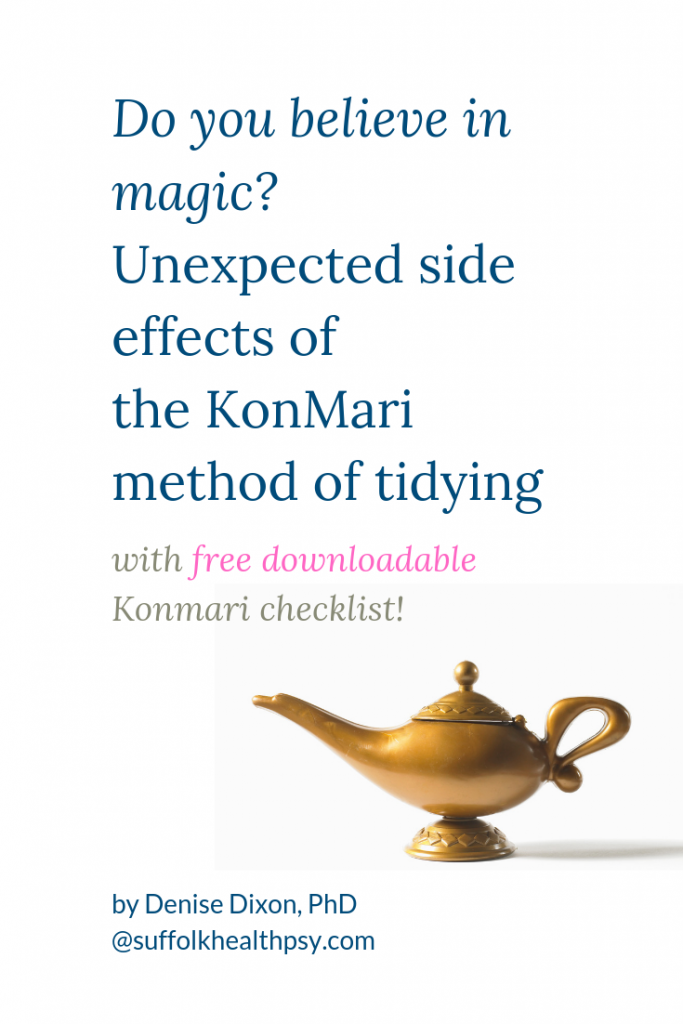
Final thoughts about potential side effects of the KonMari method of tidying
The process of sorting in silence, and alone — while quite intense — allows us to confront uncomfortable feelings, such as overwhelm, anxiety and sadness. However, allowing ourselves to lean into this discomfort, can gift us with appreciation, calm, and — yes! — even joy.

It may be helpful to remember that feelings of overwhelm, anxiety, and sadness are all normal, and to be expected. However, if these feelings become incapacitating, then it is wise to seek professional help from a licensed mental health professional. There is never a need to go it, alone! Taking good care of ourselves is always the best course of action. Am I right?
That’s all, dear blog readers. I hope that you enjoyed this blog post!
In the next blog post, we will leave KonMari, and journey into the adventures of parenting teenagers. For now, here is yet another helpful infographic:
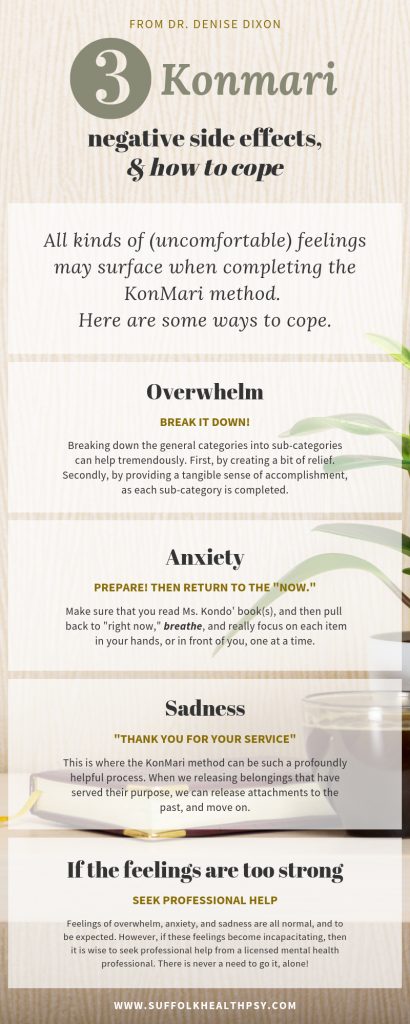
Do you have a suggestion for a blog post? I’d love to hear from you! Simply click here to tell me all about your idea. Thank you!

